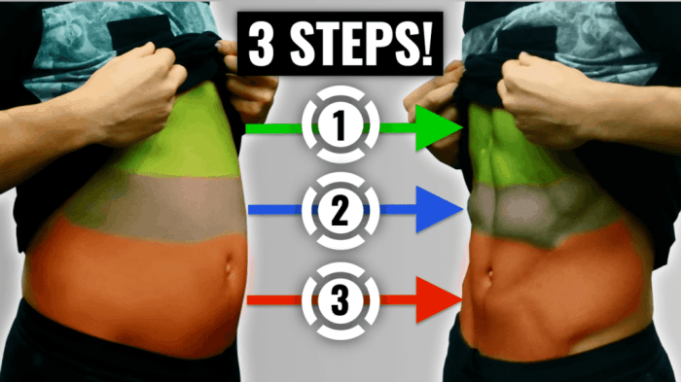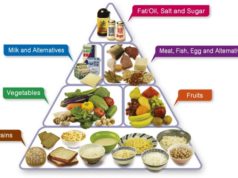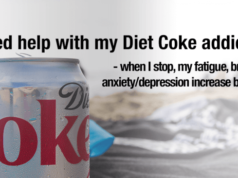How to lose weight in your stomach and thighs is a common goal, but achieving it requires a comprehensive approach. While spot reduction is a myth, focusing on overall fat loss can lead to targeted results. This guide delves into the science behind fat loss, explores effective dietary and exercise strategies, and emphasizes the importance of lifestyle modifications for sustainable weight management.
Understanding the science of fat loss is crucial. Genetics, body composition, and hormonal factors play a role in where we store fat. While we can’t target specific areas for fat loss, focusing on overall weight loss through a combination of diet and exercise will lead to a reduction in fat in the stomach and thighs.
Understanding Targeted Fat Loss
It’s common to want to lose weight in specific areas, like the stomach and thighs. While the idea of “spot reduction” – targeting fat loss in a particular area – is appealing, it’s not always realistic. Let’s delve into the science behind fat loss and understand how to approach weight loss in a way that promotes overall health and body composition.
The Science of Fat Loss
Spot reduction, the idea that you can target fat loss in specific areas through exercise, is largely a myth. While exercising a muscle group might strengthen and tone it, it doesn’t directly burn fat in that area. Fat loss occurs when you create a calorie deficit – consuming fewer calories than you burn.
This deficit leads to your body utilizing stored fat for energy, and the body decides where to pull that fat from based on various factors.
Genetics and Body Composition
Genetics plays a significant role in how your body stores and loses fat. Some people naturally tend to store more fat in their abdominal area, while others might store more in their hips and thighs. This is influenced by hormones, genetics, and lifestyle factors.
Additionally, your body composition, the ratio of muscle to fat, also influences where you lose fat first.
Creating a Realistic Approach
Instead of focusing solely on spot reduction, adopt a holistic approach that promotes overall weight loss and healthy body composition. This involves:
- Calorie Deficit:Consuming fewer calories than you burn is crucial for weight loss. This can be achieved through a balanced diet that prioritizes whole foods, portion control, and mindful eating habits.
- Regular Exercise:Engaging in regular physical activity is essential for burning calories, building muscle, and boosting metabolism. Aim for a mix of cardio and strength training exercises for optimal results.
- Strength Training:Strength training helps build muscle, which boosts metabolism and increases your calorie burn even at rest. This can contribute to fat loss in the long run.
- Patience and Consistency:Fat loss is a gradual process. Be patient with yourself and focus on making sustainable lifestyle changes that you can maintain over time.
Remember, sustainable weight loss is about creating healthy habits that you can maintain for the long term. Focusing on overall health and body composition through a balanced diet and regular exercise is more effective than trying to target specific areas.
Dietary Strategies
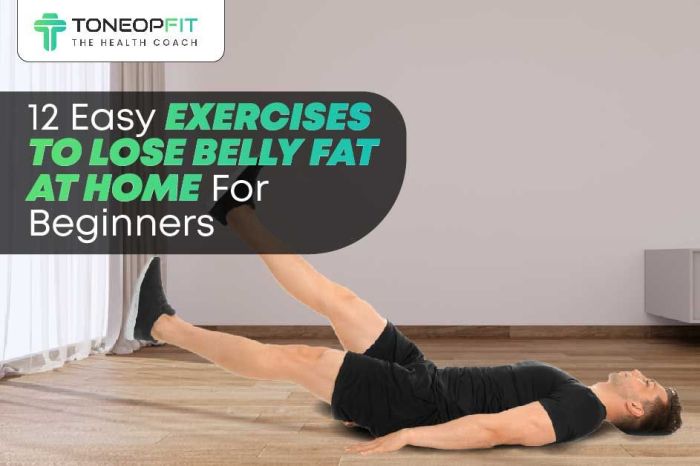
A well-structured diet plays a pivotal role in achieving your weight loss goals, especially when targeting fat reduction in the stomach and thighs. This section will delve into specific dietary strategies that promote fat burning and satiety, offering a sample meal plan and highlighting the importance of portion control and mindful eating habits.
We’ll also discuss the role of hydration in weight management.
Targeting weight loss in specific areas like your stomach and thighs requires a comprehensive approach. While spot reduction is a myth, focusing on overall fat loss and building muscle can help sculpt your physique. A balanced diet plays a crucial role in this process, and understanding the best diet for weight loss and muscle gain is essential.
The best diet for weight loss and muscle gain combines nutrient-rich foods with proper portion control, ensuring you fuel your body for both fat burning and muscle building. Remember, consistent exercise is equally important for achieving your desired results in your stomach and thighs.
Foods That Promote Fat Burning and Satiety
Consuming foods that promote fat burning and satiety is essential for sustainable weight loss. These foods are rich in nutrients and help you feel fuller for longer, reducing cravings and preventing overeating. Here’s a comprehensive list:
- Lean Protein:Lean protein sources like chicken breast, fish, turkey, beans, lentils, and tofu are essential for building and maintaining muscle mass. Muscle tissue burns more calories at rest than fat tissue, aiding in fat loss. Protein also promotes satiety, keeping you feeling full for longer.
- Fiber-Rich Foods:Fiber-rich foods like fruits, vegetables, whole grains, and legumes slow down digestion, promoting a feeling of fullness and reducing calorie intake. Soluble fiber, found in oats, beans, and apples, can help lower cholesterol levels, which is beneficial for overall health.
- Healthy Fats:Incorporating healthy fats like those found in avocados, nuts, seeds, and olive oil is crucial for hormone regulation and satiety. These fats also support the absorption of fat-soluble vitamins, ensuring optimal nutrient utilization.
- Water-Rich Foods:Fruits and vegetables high in water content, such as cucumbers, watermelon, and spinach, contribute to hydration and satiety. They are low in calories and help you feel fuller for longer.
- Spice Up Your Meals:Spices like ginger, turmeric, and cayenne pepper can boost metabolism and promote fat burning. These spices also add flavor to your meals, making them more enjoyable and helping you stick to your diet.
Sample Meal Plan
This sample meal plan demonstrates how to incorporate whole, unprocessed foods into your daily diet:
| Meal | Food Choices |
|---|---|
| Breakfast | Oatmeal with berries and nuts, Greek yogurt with fruit and granola, scrambled eggs with spinach and whole-wheat toast |
| Lunch | Salad with grilled chicken or fish, lentil soup with whole-wheat bread, vegetable stir-fry with brown rice |
| Dinner | Salmon with roasted vegetables, chicken breast with quinoa and steamed broccoli, tofu scramble with brown rice and bell peppers |
| Snacks | Fruit, nuts, Greek yogurt, hard-boiled eggs |
Portion Control and Mindful Eating
Portion control and mindful eating are crucial for weight management. It’s not just about what you eat, but also how much you eat.
- Use Smaller Plates:Using smaller plates can visually trick your brain into thinking you’re eating more, leading to a sense of satisfaction with smaller portions.
- Eat Slowly and Mindfully:Chew your food thoroughly and savor each bite. This allows your body to register fullness signals and prevents overeating.
- Listen to Your Body:Pay attention to hunger and fullness cues. Don’t eat out of boredom or stress.
Hydration
Water is essential for weight management. It helps you feel full, boosts metabolism, and flushes out toxins.
- Drink Water Before Meals:Drinking water before meals can help you feel fuller, leading to reduced calorie intake.
- Carry a Water Bottle:Keeping a water bottle with you throughout the day makes it easier to stay hydrated. Aim for 8 glasses of water daily.
- Choose Water Over Sugary Drinks:Avoid sugary drinks like soda and juice, as they are high in calories and contribute to weight gain.
Exercise for Stomach and Thighs: How To Lose Weight In Your Stomach And Thighs
To achieve targeted fat loss in your stomach and thighs, incorporating specific exercises that work these areas is crucial. While spot reduction is not possible, focusing on these areas can help build muscle and increase calorie expenditure, contributing to overall fat loss.
Effective Exercises for Stomach and Thighs
Here’s a list of exercises that effectively target the stomach and thigh areas:
- Plank:This isometric exercise strengthens your core muscles, including your abdomen, lower back, and obliques.
- Crunches:This classic abdominal exercise targets your upper abs, helping to define your stomach area.
- Leg Raises:This exercise targets your lower abs and hip flexors, strengthening your core and improving your lower body stability.
- Squats:Squats are a compound exercise that works multiple muscle groups, including your quadriceps, hamstrings, glutes, and calves. They are essential for building lower body strength and toning your thighs.
- Lunges:Lunges are another compound exercise that targets your quadriceps, hamstrings, and glutes, helping to sculpt your thighs and improve your balance.
- Deadlifts:Deadlifts are a powerful exercise that engages your entire posterior chain, including your hamstrings, glutes, and lower back. They are effective for building muscle and burning calories.
- Burpees:Burpees are a full-body exercise that combines a squat, push-up, and jump, providing a high-intensity workout that targets your stomach, thighs, and other muscle groups.
Sample Workout Routine, How to lose weight in your stomach and thighs
Here’s a sample workout routine that combines cardio and strength training to target your stomach and thighs:
- Warm-up:5 minutes of light cardio, such as jogging or jumping jacks.
- Strength Training:
- Plank (30 seconds, 3 sets)
- Crunches (15-20 reps, 3 sets)
- Leg Raises (15-20 reps, 3 sets)
- Squats (15-20 reps, 3 sets)
- Lunges (10-12 reps per leg, 3 sets)
- Cardio:20-30 minutes of moderate-intensity cardio, such as running, cycling, or swimming.
- Cool-down:5 minutes of stretching.
Benefits of High-Intensity Interval Training (HIIT)
HIIT involves alternating between short bursts of intense exercise and brief recovery periods. This type of training has numerous benefits for fat loss, including:
- Increased calorie expenditure:HIIT workouts burn more calories than steady-state cardio, even after the workout is over.
- Improved cardiovascular health:HIIT can enhance your heart health by improving your heart rate and blood flow.
- Increased muscle mass:HIIT workouts stimulate muscle growth, which can help boost your metabolism and burn more calories.
- Time efficiency:HIIT workouts are typically shorter than traditional cardio sessions, making them a time-efficient way to exercise.
Proper Form and Technique
Proper form and technique are crucial for maximizing results and preventing injuries. Here are some tips for proper form:
- Engage your core:Keeping your core engaged throughout your workouts helps stabilize your body and prevent injuries.
- Maintain a neutral spine:Avoid arching or rounding your back during exercises, especially those involving lifting weights.
- Control the movement:Perform exercises slowly and with control, avoiding jerky or sudden movements.
- Listen to your body:If you experience any pain, stop the exercise and consult with a healthcare professional.
Lifestyle Modifications
Lifestyle modifications play a crucial role in achieving and maintaining a healthy weight. These changes go beyond just diet and exercise and encompass aspects of your daily routine that contribute to your overall well-being.
Incorporating More Movement into Daily Life
Making small changes to your daily routine can significantly increase your activity levels.
- Take the stairs instead of the elevator whenever possible.
- Walk or cycle to work or errands if feasible.
- Get off the bus or train a stop earlier and walk the rest of the way.
- Stand up and move around every hour if you have a desk job.
- Engage in activities you enjoy, such as dancing, swimming, or gardening.
These simple adjustments can help you burn more calories and improve your overall fitness.
Targeting weight loss in specific areas like your stomach and thighs requires a holistic approach. While you can’t spot reduce fat, focusing on overall weight loss can help you achieve a more toned physique. A healthy diet and regular exercise are key, and sometimes, a quick boost can be helpful.
Check out this guide on how to lose weight in a week naturally for some inspiration. By combining these strategies with consistent effort, you’ll be well on your way to achieving your weight loss goals, including those stubborn areas like your stomach and thighs.
The Importance of Quality Sleep
Sleep is not just a time for rest; it’s crucial for weight management. When you don’t get enough sleep, your body produces more of the hunger hormone ghrelin and less of the satiety hormone leptin, making you feel hungrier and more likely to overeat.
Sleep deprivation also affects your metabolism, making it harder to burn calories.
- Aim for 7-9 hours of quality sleep each night.
- Establish a regular sleep schedule, going to bed and waking up around the same time each day.
- Create a relaxing bedtime routine to help you unwind.
- Make sure your bedroom is dark, quiet, and cool.
Stress Management
Chronic stress can lead to weight gain. When you’re stressed, your body releases the hormone cortisol, which can increase appetite and lead to cravings for unhealthy foods. Stress can also disrupt sleep, further contributing to weight gain.
Targeting specific areas like the stomach and thighs for weight loss can be tricky, but focusing on overall healthy habits is key. A balanced diet, regular exercise, and staying hydrated are crucial, and you can find tips on how to lose weight fast and healthy at home here.
Remember, consistency is key, and while you may not see immediate results in specific areas, overall weight loss will eventually impact those areas too.
- Identify your stress triggers and develop coping mechanisms to manage them.
- Practice relaxation techniques such as deep breathing, meditation, or yoga.
- Engage in activities you enjoy, such as spending time with loved ones, listening to music, or reading.
- Prioritize self-care and make time for activities that help you de-stress.
The Role of Sleep, Stress, and Overall Well-being in Weight Loss
Sleep, stress, and overall well-being are interconnected and play a vital role in weight loss. When you prioritize these aspects, you create a foundation for sustainable weight management.
- Quality sleep helps regulate hormones that control appetite and metabolism, promoting healthy weight loss.
- Managing stress reduces cortisol levels, which can lead to cravings and weight gain.
- Overall well-being encompasses a healthy lifestyle that includes balanced nutrition, regular exercise, and emotional well-being, all of which contribute to weight loss and maintenance.
Building a Sustainable Routine
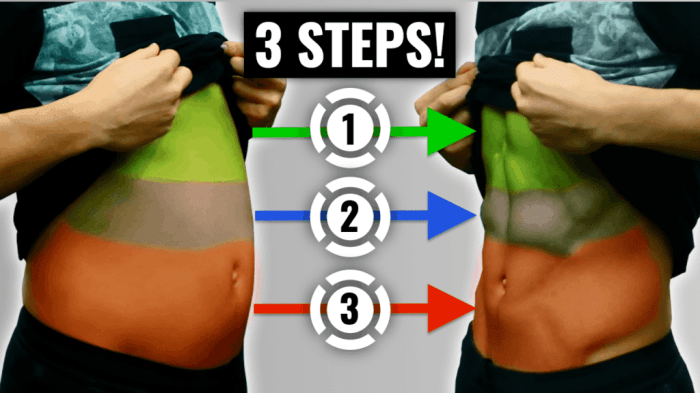
Losing weight and keeping it off isn’t just about a quick fix; it’s about building healthy habits that you can maintain for the long haul. A sustainable weight loss plan is one that you can stick to over time, even when life gets busy or you hit a plateau.
This section will guide you through the process of creating a plan that works for you and help you develop strategies for staying motivated and on track.
Setting Realistic Goals and Tracking Progress
Setting achievable goals is crucial for success. Aim for gradual weight loss of 1-2 pounds per week. This is a healthy and sustainable rate that allows your body to adjust gradually. Tracking your progress helps you stay motivated and see the results of your efforts.
This can be done through a variety of methods, such as keeping a food diary, using a fitness tracker, or taking regular measurements.
- Set SMART Goals:SMART stands for Specific, Measurable, Achievable, Relevant, and Time-bound. For example, instead of saying “I want to lose weight,” try “I want to lose 10 pounds in the next 3 months by eating a balanced diet and exercising 3 times a week.”
- Track Your Food Intake:Use a food journal, a calorie-tracking app, or even a simple notebook to record what you eat. This helps you become more aware of your eating habits and identify areas where you can make changes.
- Monitor Your Exercise:Keep track of your exercise sessions, including the type of activity, duration, and intensity. This helps you stay consistent and see how your fitness level is improving.
- Measure Your Progress:Take regular measurements, such as your weight, waist circumference, and body fat percentage. This gives you a more comprehensive picture of your progress than just relying on the scale.
Staying Motivated and Overcoming Plateaus
Staying motivated is essential for maintaining a healthy weight loss plan. Plateaus are a normal part of the weight loss journey, but they can be discouraging. It’s important to have strategies in place to overcome these obstacles and keep moving forward.
- Find a Support System:Surround yourself with people who support your goals. This could be friends, family, or a weight loss group. Sharing your journey with others can provide encouragement and accountability.
- Celebrate Your Successes:Acknowledge and reward your achievements, no matter how small they may seem. This helps you stay positive and motivated.
- Focus on Non-Scale Victories:Don’t get too fixated on the number on the scale. Celebrate other positive changes, such as increased energy levels, improved sleep, or better fitting clothes.
- Adjust Your Plan:If you hit a plateau, don’t give up. It may be time to make adjustments to your diet or exercise routine. Consider increasing the intensity or duration of your workouts, trying a new type of exercise, or consulting with a registered dietitian for personalized dietary guidance.
Resources and Tools for Long-Term Weight Management
There are numerous resources and tools available to support your long-term weight management goals. These can provide valuable information, guidance, and support as you navigate the journey.
- Registered Dietitians:A registered dietitian can provide personalized dietary advice and help you create a balanced eating plan that meets your individual needs.
- Certified Personal Trainers:A certified personal trainer can help you develop a safe and effective exercise program tailored to your fitness level and goals.
- Weight Loss Apps:Many apps are available to track your food intake, exercise, and progress. Some apps also offer features such as recipes, meal planning, and support groups.
- Support Groups:Joining a weight loss support group can provide a sense of community and shared experiences. This can be a valuable resource for motivation, encouragement, and accountability.
Ending Remarks
Losing weight in your stomach and thighs is a journey that requires dedication and consistency. By understanding the science behind fat loss, adopting a balanced diet, engaging in regular exercise, and making healthy lifestyle choices, you can achieve your weight loss goals and enjoy a healthier, more confident you.
Remember, patience and perseverance are key, and celebrate every milestone along the way.
FAQ Resource
Is it possible to lose weight only in my stomach and thighs?
While you can’t target specific areas for fat loss, focusing on overall weight loss through a combination of diet and exercise will lead to a reduction in fat in the stomach and thighs.
What are some common mistakes people make when trying to lose weight?
Common mistakes include relying on fad diets, skipping meals, not getting enough sleep, and not being consistent with exercise.
How long does it take to see results?
The time it takes to see results varies depending on individual factors such as starting weight, diet, exercise, and genetics. It’s important to be patient and focus on making sustainable lifestyle changes.















